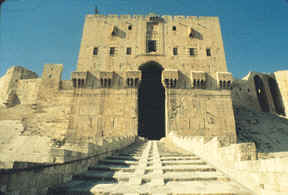Archaeologists believe that human beings settled on the hilltop that became Aleppo, some 350 km (225 miles )north of Damascus, around eight thousand years ago. Its Arabic name, Haleb, is said to derive from Haleb Ibrahim, Milk of Abraham, for the sheep’s milk the biblical patriarch offered to travelers in Aleppo’s environs.
“It is an excellent city without equal for the beauty of its location, the grace of its construction and the size and symmetry of its marketplaces,” wrote the great Arab Voyager Ibn Battota about this city when he visited it in 1348.
Aleppo was one of Islam’s most important cities like Damascus, Constantinople and Cairo. The modern Lebanese historian Antoine Abdel Nour praised it in his Introduction “à l’histoire urbaine de la Syrie ottoman”.
“Its beauty reveals itself in the elegance of its stone architecture, redolent of historic links to Byzantium and Venice; and in the diversity of its cultures,” wrote the editor Charles Glass.
In the old part of Aleppo, a walled structure on what looks like a hill would strike your eye. As you reach the entrance, you can feel that it includes rich and diverse cultures. It is a marvelous example of Arab military architecture.
Aleppo citadel, which is listed by the UNESCO as a world heritage site, was built in the days of Sayf al-Dawla al-Hamadani , and lies in ruins of earlier civilizations. It has always been important – both strategically and military.
Its’ designers did everything to make the fortification impossible to penetrate, and this becomes clear when you approach the entrance.
On the north and south sides, you can see great tours rise above the moat, 20 m deep and 30 m wide. While walking inside, you would enter a small door and climb up to the Byzantine hall and the royal palace , and enter the museum containing relics uncovered during restoration and reconstruction.
The main attraction of the citadel, 50 m over the city, is a magnificent view of Aleppo and its surroundings from Ibrahim’s Mosque whose square minaret is 21 m high.
The other attraction of the city is the high walls of ancient Aleppo with fortified doors (Hadid, Antakia, and Qinsrin) which are marvelous example of Islamic military architecture.
As one of the oldest inhabited cities in the world with its rich stories of the many ancient travelers and merchants who crossed the Silk Road, Aleppo’s beauty is indeed hard to compare.
Basma Qaddour

